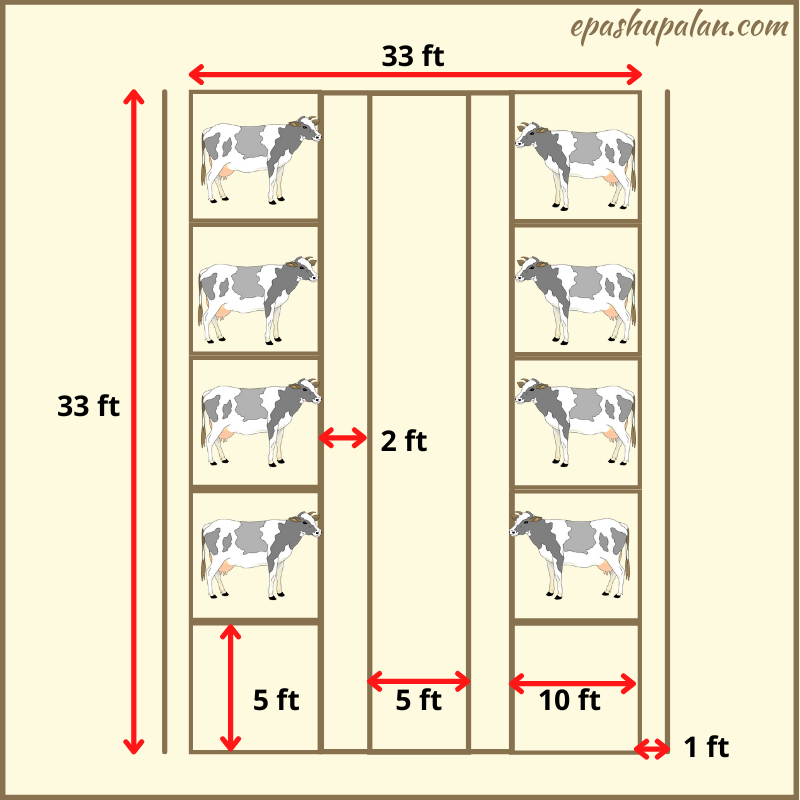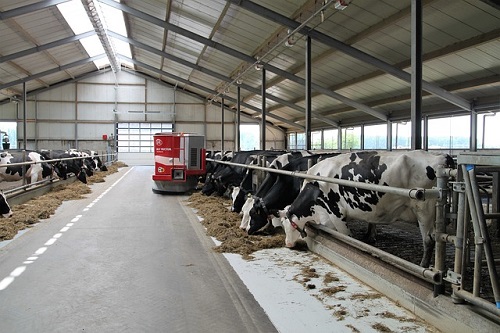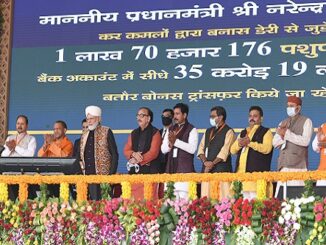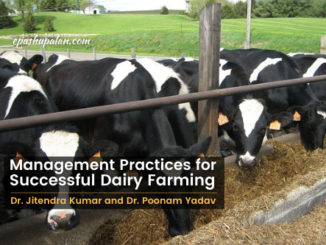Introduction
Dairying is an important source of subsidiary financial gain to small/marginal farmers and agricultural labourers. In addition to milk and milk products, the manure from animal’s supplies organic matter for improving soil fertility and crop yields. The surplus fodder and agricultural by-products are gainfully used for feeding the animals. Since agriculture is usually seasonal, there is a clear chance for finding employment throughout the year for several persons through dairying.
Scope for Dairy Farming
India possess the largest livestock population in the world. It accounts for about 57.3% of the world’s buffalo population and 14.7% of the cattle population. The total milk production in the country is over 200 million ton per annum at the end of the Eleventh Plan (2019-20) and the demand is expected to be 220 million ton by 2025. To attain this demand annual growth rate in milk production has to be increased from the present 2.5% to 5%. The Annual growth rate for milk production is naerly 6% in 2019-20. Thus, there is an incredible scope/potential for increasing the milk production through profitable dairy farming.
National Importance and DESI Breeds Conservation
India is home to large diversified cattle genetic resources, having more than 190.9 million cattle and so far forty three registered desi cattle breeds. These breeds are specially adapted to different agro-climatic conditions and their genetic diversity is well established due to the process of domestication over the centuries. There is decrease of 4.10% in cattle population and 3.14% in cattle genetic resources of India as compared to the later livestock census. The crossbred population has been increased by 20.18% during the period of last census while population of desi cattle has been decreased by 8.94% during the same duration. The reasons for depletion of breeds includes crossbreeding with exotic breeds, economically less viable, loosing utility, reduction in herd size and the large scale mechanization of agricultural operation. The native breeds need to be conserved for genetic insurance in future, scientific study, as a part of our ecosystem, cultural and ethical requirements and for energy sources in future. The indigenous breeds of cattle posses various unique characteristics such as the presence of unique genetic variation in HSP70 gene family, carry a ‘thermometer gene’ and presence of A2 allelic variant in cow milk, which makes them well adapted to the tropical climate.
The conservation includes the preservation along with up-gradation (improvement) of the genetic potential and management of a breed for use in future. The effective management of indigenous cattle resources includes identification, characterization, evaluation, documentation and conservation. The future strategy should be to combine genetic improvement and conservation.
The demands for food products derived from animal are rapidly increasing around the growing population of world with more of consumer specified demands i.e., hygiene and quality. However, conservation of desi cows is also much important instead commercial food products manufacturing. Hence new scientific farming systems which yield more production and profits with sustainability have to be practiced
Indigenous milch Breeds

- This breed is called as Bhadawari, Desan, Gujarati, Kathiawari, Sorthi, and Surati.
- Originated in Gir forests of South Kathiawar in Gujarat also found in Maharashtra and adjacent Rajasthan.
- Basic colours of skin are white with dark red or chocolate-brown patches or sometimes black or purely red.
- Horns are peculiarly curved, giving a ‘half moon’ appearance.
- Milk yield ranges from 1600-1800 kgs per lactation.
- This breed is known for its hardiness and disease resistance.

- Originated in Montgomery region of undivided India.
- This breed otherwise known as Lola (loose skin), Lambi Bar, Montgomery, Multani.
- Best indigenous dairy breed.
- Reddish dun or pale red in colour, sometimes flashed with white patches.
- Heavy breed with symmetrical body having loose skin.
- The average milk yield of this breed is between 1400 and 2500 kgs per lactation.
- Kankrej
- It is otherwise called as Wadad or Waged, Wadhiar.
- Originated from Southeast Rann of Kutch of Gujarat and adjoining Rajasthan.
- The horns are lyre-shaped.
- Colour of the animal varies from silver-grey to iron-grey or steel black.
- The gait of Kankrej is peculiar called as 1 ¼ paces (sawai chal).
- Kankrej is valued for fast, powerful, draught cattle. Useful in ploughing and carting.
- The cows are good milkers, yielding about 1400 kgs per lactation.
Production Technology
- Project Location
Desi cow breeds farm will be setup where conservation of desi cows is going on.
- Housing
At Low cost galvanized iron sheet roof housing will be constructed by establishing iron pillars. Floor and side walls will be made of concrete material. Average floor space for Cow – 55 sq.ft and Calf- 20 sq.ft.
- Feed and Fodder cultivation
Fertile land with assured irrigation facilities is available so that fodder crops could be successfully raised and abundant good quality green fodders will be made available for animal feeding throughout the year.
- Water
Good quality fresh water for animal drinking and for the cleaning, washing etc. is available.
- Labour
Honest, economic and regular supplies of labours are available.
- Veterinary Aid
Experienced Veterinary doctor is working the organization which has proposed project.
- Market potential
Milk Consumption Pattern in India: Liquid milk 46%, Ghee 28%, Butter 6.5%, Curd 7%, Khoa 5.5%, Milk Powder 3.6%, Cheese 2% and other products 1.6%.
Majority of the Indian Population consume milk. Purchasing power of the people is on the rise and there is a distinct shift in consumption patterns and desi ghee is now becoming almost an essential part of the diet as it is derived from A2 milk and people are getting attracted towards desi animals products. Availability of desi ghee is less than the demand. It requires smaller investments and is not as risky a business proposition as compared to milk where it is highly perishable and need to reach market daily. Sale of desi ghee is never a problem for the above mentioned reasons. The demand for desi milk and ghee is increasing faster. Hence it becomes obvious to supply what is needed in the market.
- Export Potential
The scope for exports too is huge, however for selling desi ghee abroad one has to adhere to strict phyto-sanitary conditions and standards of the respective nations.
Conclusion
With the above details provided the proposed desi cow dairy unit is technically feasible and financially viable.
Project Report for Establishment Dairy farm of 10 Desi Cows
I. Capital Cost
A. Shed Construction
| SN. | Particulars | Unit
(sq. ft) |
Rate (Rs.) | Area
(sq. ft) |
Total (Rs.) |
| 1. | 10 Cows@ 65 sq. ft/Cow | 1 | 400 | 650 | 2,60,000 |
| 2. | Calves Shed
5 Calves @20 sq.ft/calf |
1 | 400 | 100 | 40,000 |
| 3. | Pregnant Cow Shed
2 Pregnant Cows @ 75 sq.ft/cow |
1 | 400 | 150 | 60,000 |
| 4. | Milking Parlour
2 Milking Cows @ 60 sq. ft/cow |
1 | 400 | 120 | 48,000 |
| Total | 1020 | 4,08,000 | |||
B. Cow Purchase
| SN. | Particulars | Unit | Rate (Rs.) | Quantity (Nos) | Total (Rs.) |
| 1. | Gir Cows | 1 | 65,000 | 4 | 2,60,000 |
| 2. | Kankrej Cows | 1 | 65,000 | 4 | 2,60,000 |
| 3. | Sahiwal Cows | 1 | 65,000 | 2 | 1,30,000 |
| 4. | Transportation | 1 | 18,000 | 10 | 1,80,000 |
| Total | 8,30,000 | ||||
C. Equipments
| SN. | Particulars | Rate
(Rs.) |
Quantity (Nos) | Total
(Rs.) |
| 1. | 10 Cows @ Rs.1000/- for each cow | 1000 | 10 | 10000 |
| 2. | Rubber Mat | 1000 | 10 | 10000 |
| 3. | Butter Making Machine | 30000 | 1 | 30000 |
| 4. | Ghee Boiler | 5000 | 1 | 5000 |
| Total | 55,000 | |||
D. FSSAI Registration and Marketing Licensing
| SN. | Particulars | Total (Rs.) |
| 1. | FSSAI Registration | 3,000 |
| 2. | FSSAI Licensing Charges | 3,000 |
| Total | 6,000 | |
Total Capital Cost (A+B+C+D) = Rs.12, 99,000
II. Herd Projection (No. of livestock increase projection)
| Years | 1 | 2 | 3 | 4 | 5 | 6 |
| Cow | 10 | 10 | 10 | 15 | 18 | 22 |
| Heifer | – | 3 | 6 | 3 | 6 | 7 |
| Female Calves | 4 | 4 | 4 | 7 | 8 | |
| Male Calves | 4 | 4 | 4 | 7 | 8 |
III. Recurring Cost
| SN. | Particulars | Unit | Rate (Rs.) | Quantity (Nos) | Total (Rs.) |
| 1. | Fodder 10 Cows @25 Kg/Cow | Ton | 0.3 | 100 | 30,000 |
| 2. | Dry Fodder 10 Cows
(@ 5 Kg/Cow) |
Kg | 5 | 50 | 18,250 |
| 3. | Concentrate | ||||
| Lactation 300 days
10 Cows @4 Kg/Cow |
Kg | 23 | 12,000 | 2,76,000 | |
| Dry Period 65 days
10 Cows @1.5 Kg/Cow |
Kg
|
23 | 975 | 22,425 | |
| Total Feeding Cost | 3,46,675 | ||||
| 4. | Insurance of animal cost
@ 4.5% – 2.5% (Premium – KMF Subsidy) |
– | 1,300
|
10 | 13000 |
| 5. | Veterinary Expenses | – | 1000 | 10 | 10000 |
| 6. | Water | 10000 | |||
| 7. | Electricity | 10000 | |||
| 8. | Labour Shift wise | – | 9,000 | 2 | 2,16,000 |
| 9. | Marketing Charges
(Glass jar + label + transportation) |
– | 50 | 700 | 35,000 |
| 10. | Advertising charges | – | 3000 | 1 | 3000 |
| Total Recurring Cost | 6,43,675 | ||||
Abstract
Capital cost: Rs. 12, 99,000
Recurring cost: Rs. 6, 43,675
Total: Rs. 19, 42,675
IV. Economics
| SN | Particulars | Quantity | Unit (Rs.) | Ist Year
Total (Rs.) |
IInd Year
Total (Rs.) |
IIIrd Year
Total (Rs.) |
| A. Income | ||||||
| 1. | Sale of Ghee
(1,700 Ltrs milk/cow/lactation) |
680 Kg | 1400 | 9,52,000 | 9,52,000 | 9,52,000 |
| 2. | Sale of Manure
(1 ton/cow/year) |
10 | 8 | 80,000 | 80,000 | 80,000 |
| 3. | Sale of Gomutra (100 L/Cow/Yr) | 10 | 20 | 20,000 | 20,000 | 20,000 |
| Total-A | 10,52,000 | 10,52,000 | 10,52,000 | |||
| B. Expenditure | ||||||
| 1. | Feeding cost | – | – | 3,46,675 | 3,46,675 | 3,46,675 |
| 2. | Insurance | – | – | 13,000 | 13,000 | 13,000 |
| 3. | Veterinary Expenses | – | – | 10,000 | 10,000 | 10,000 |
| 4. | Water | – | – | 10,000 | 10,000 | 10,000 |
| 5. | Electricity | – | – | 10,000 | 10,000 | 10,000 |
| 6. | Labour | – | – | 2,16,000 | 2,16,000 | 2,16,000 |
| 7. | Marketing charges (Glass jar + label + transportation) | – | – | 35,000 | 35,000 | 35,000 |
| 8. | FSSAI renewal charges | – | – | 3,000 | 3,000 | 3,000 |
| Total-B | 6,43,675 | 6,43,675 | 6,43,675 | |||
| Gross Profit (A-B) | 4,08,325 | 4,08,325 | 4,08,325 | |||
| SN | Particulars | IV Year | V Year | ||||
| Qty(Kg) | Unit (Rs.) | Total (Rs.) | Qty(Kg) | Unit (Rs.) | Total (Rs.) | ||
| A. Income | |||||||
| 1. | Sale of Ghee
1,700 Lts milk/cow/lactation |
1,020 | 1,600 | 16,32,000 | 1,224 | 1,600 | 19,58,400 |
| 2. | Sale of Manure
(1 ton/cow/year) |
15 | 8 | 1,20,000 | 18 | 8 | 1,44,000 |
| 3. | Sale of Gomutra
(100 Ltr/Cow/Year) |
15 | 20 | 30,000 | 18 | 20 | 36,000 |
| Total-A | 17,82,000 | ||||||
| B. Expenditure | |||||||
| 1. | Feeding cost | – | – | 5,19,000 | – | – | 6,24,015 |
| 2. | Insurance | – | – | 19,500 | – | – | 23,400 |
| 3. | Veterinary Expenses | – | – | 15,000 | – | – | 18,000 |
| 4. | Water | – | – | 10,000 | – | – | 10,000 |
| 5. | Electricity | – | – | 10,000 | – | – | 10,000 |
| 6. | Labour | – | – | 2,40,000 | – | – | 2,40,000 |
| 7. | Marketing charges (Glass jar + label + transportation) | – | – | 52,500 | – | – | 62,500 |
| 8. | FSSAI renewal charges | – | – | 3,000 | – | – | 3,000 |
| Total-B | 8,69,000 | 9,88,215 | |||||
| Gross Profit (A-B) | 9,13,000 | 11,50,185 | |||||
V. Net Profit
| SN. | Particulars | Years ( Rs.) | ||||
| 1 | 2 | 3 | 4 | 5 | ||
| 1. | Gross Profit | 4,08,325 | 4,08,325 | 4,08,325 | 9,13,000 | 11,50,185 |
| 2. | Interest @ 8% | 1,55,414 | 1,24,331 | 93,249 | 62,167 | 31,083 |
| 3. | Repayment | 3,88,535 | 3,88,535 | 3,88,535 | 3,88,535 | 3,88,535 |
| Net Profit (1-(2+3)) | -1,35,624 | -1,04,541 | -73,249 | 4,62,298 | 7,30,567 | |
VI. Repayment Schedule in ( Rs.)
| Year | Loan Amount | Installment | Interest @ 8% p.a. |
| I | 19, 42,675 | 3,88,535 | 1,55,414 |
| II | 15,54,140 | 3,88,535 | 1,24,331 |
| III | 11,65,605 | 3,88,535 | 93,249 |
| IV | 7,77,070 | 3,88,535 | 62,167 |
| V | 3,88,535 | 3,88,535 | 31,083 |
| Total | 19, 42,675 | 4,66,244 | |
VII. Sensitivity Test in ( Rs.)
| Profit | Loss | |||||
| Year | Actual | 10% | 20% | 10% | 20% | 50% |
| I | 4,08,325 | 4,49,157 | 4,89,990 | 3,67,492 | 3,26,660 | 2,04,162 |
| II | 4,08,325 | 4,49,157 | 4,89,990 | 3,67,492 | 3,26,660 | 2,04,162 |
| III | 4,08,325 | 4,49,157 | 4,89,990 | 3,67,492 | 3,26,660 | 2,04,162 |
| IV | 9,13,000 | 10,04,300 | 10,95,600 | 8,21,700 | 7,30,400 | 4,56,500 |
| V | 11,50,185 | 12,65,204 | 13,80,222 | 10,35,167 | 9,20,148 | 5,75,092 |
| Total | 32,88,160 | 36,16,977 | 39,45,792 | 29,59,345 | 26,30,528 | 16,44,080 |
VIII. Stock clearance if we want to close the running project
| Particulars | Numbers | Rate | Total amount |
| Total cows | 22 | @ 50,000 | 11,00,000 |
| Heifers | 7 | @ 40,000 | 2,80,000 |
| Infrastructure (50%) | – | – | 2,31,500 |
| Total | 16,11,500 | ||
IX. Model Layout for Construction of Shed Head to Head Method


Modifications will be according to our locality needs such as manger and walking space.






Sir, my name is Anurag Mishra, I am doing dairy work for a long time, now I want to increase it and make it bigger, I have also done diploma from NDRI Karnal as experience but can’t do any bank loan.
Dear Dr Rakshit Raj
Congratulations to you for very good informative model project with all required information. This would help the students for learning how to make a project. If you share your paper, I would like to share with my students.
Thanks & regards
Very good Information.. complete knowledge to start a dairy farm. Thank you Doctor and epashupalan for such article..🙏🙏🙏
Very nice information great job Doctor thanks and regards